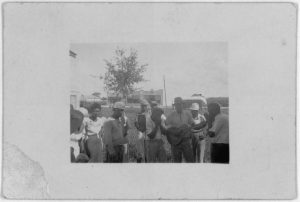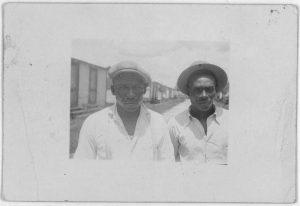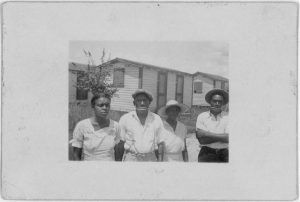As I was browsing the Lomax Collection on the Library of Congress a picture of people playing music together popped out at me. The caption identified the three musicians as Booker T. Sapps and Roger Matthews on harmonica, and Willie Flowers on guitar. While there is very little information out there on these musicians, I was able to find information on the use of the harmonica in American music that helps contextualize, as well as a recording of Booker T. Sapps and Roger Matthews that helps bring their memory to life.

Roger Matthews (harmonica), Willie Flowers (guitar), Booker T. Sapps (harmonica), Belle Glade, Florida
The history of the harmonica begins with the introduction of the Chinese sheng in Europe in 1777, which consequently led Europeans to expand on this free reed design in the 1800s. These first harmonicas were wooden with reeds made from brass wire. The defining addition to the harmonica, a second reed-plate, allowed a sound to be made when the player sucked in, creating the harmonica that we think of today. This design became popular quickly, and spread across Europe and beyond. This of course includes the U.S., where the harmonica was used in a variety of popular genres, most notably blues music.
The harmonica gaining popularity as an instrument in general and particularly with black folk music in the U.S. isn’t without explanation. It is small, portable, relatively inexpensive, easy to play due to its fixed notes, and does not require tuning. In short, it was accessible to black musicians that had a hard time getting their hands on instruments at the time. For the blues it was especially important as it provided an extra layer of emotion to the music, almost imitating a human voice crying or sighing in my opinion. In addition to this emotive quality the harmonica can replicate the sound of a train with chugging and whopping sounds, which we can hear on Booker T. Sapps and Roger Matthews recording entitled “The Train.”
Although we don’t know enough about the musicians themselves, there is information on Lomax’s collection and recording of the musicians. Lomax, along with his companion Hurston, traveled to the Everglades with the aim of recording black ballads. Two recording sessions took place: one in Belle Glade, and the other in Chosen. These pictures were taken at a crop-picking labor camp in Belle Glade, Florida in 1935, where Booker T. Sapps, Roger Matthews, and Willie Flowers played for Lomax and Hurston. That music, which you can listen to on the album I’ve linked above, presents us with a mesmerizing and harmonica-driven blues sound. In a letter to the Library of Congress sent that same year, “Lomax referred to the expedition as the “most exciting field trip” he had ever made.” (Bastin, 60.)
On a concluding note, I think it is important to recognize that Lomax traveled to Florida with a goal – to record black ballads. This goal, in turn, may have influenced what Sapps, Matthews, and Flowers performed for Lomax. While there is much to be learned from the recording itself, I still wish there were a way to learn more about the stories of these musicians.
Sources
Primary source from Library of Congress, Lomax Collection: [Roger Mathews harmonica, Willie Flowers guitar, and Booker T. Sapps harmonica, Belle Glade, Florida]. Belle Glade Florida United States, 1935. June. Photograph. Retrieved from the Library of Congressfile://localhost/, https/::www.loc.gov:item:2007660120 :. (Accessed September 29, 2017.)
Field Recordings Vol. 7: Florida (1935-1936). Recorded January 1, 1998. Document Records, 1998, Streaming Audio. Accessed September 29, 2017. http://search.alexanderstreet.com/view/work/bibliographic_entity%7Crecorded_cd%7C74531
Grove: Ivor Beynon, et al. “Harmonica (i).” Grove Music Online. Oxford Music Online. Oxford University Press, accessed September 29, 2017, http://www.oxfordmusiconline.com/subscriber/article/grove/music/12384.
Bastin, Bruce. Red River Blues : The Blues Tradition in the Southeast. Music in American Life. Urbana: University of Illinois Press, 1986.


